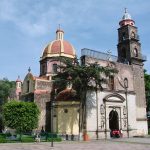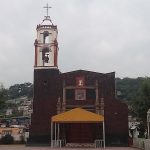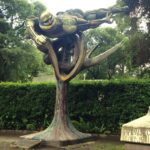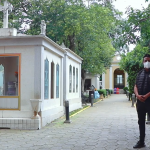San Andrés Ahuayucan, a rugged small town welcomes visitors to what are sometimes called the Xochimilco highlands. Originally the name was Ahuatla, meaning “place of pure water.” This was later changed to Ocoyoacac, “place of water and oak trees.” The name Ahuayocan or Ahuayucan, “place of oak trees,” came about in the 18th century.
The church replaced an older chapel in 1789. Interestingly, the inverted-arch atrial wall was only rebuilt in 1973. And the entire church was restored in 1983.
The town traces its history to a painting of San Andrés Apóstol, the patron saint of the church. A flood in 1708 damaged many communities in the area. The painting was found in a place called Copalhuacan, the site of the old church. The community moved then to these higher grounds, with the painting that seemed to indicate that this was the place for the church. A town of mature oak trees, these still line some of the central streets. It’s one of the original settlements of Xochimilco.
Today, the town’s two oldest neighborhoods are El Calvario and Chapultepec. The town celebrates the feast of San Andres Ahuayucan on November 30 of each year. The feast is famously accompanied by Chinelo dancers. These often outshine the town’s considerable Day of the Dead celebrations at the beginning of the same month.
The atrium of the church now competes with the kiosko, a more civic town center. It’s a few minutes walk south along the Benito Juárez avenue. That avenue, running north-south through San Andrés Ahuayucan, makes up the artery of the town’s central commercial district.
 https://www.facebook.com/sanandres.ahuayucan
https://www.facebook.com/sanandres.ahuayucan

Nearest at 1.14 kms.

Nearest at 1.33 kms.

Nearest at 1.47 kms.

A final resting place for some of Mexico's most important people . . .

A park that comes alive with colorful animals in Tláhuac . . .

One of Tláhuac's great traditional neighborhood markets . . .

One of the most haunted places in the Center of Tlalpan . . .